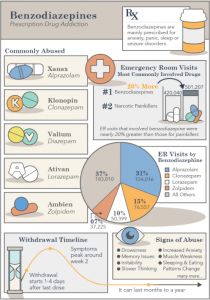Valium Addiction and Diazepam Abuse Statistics

The number of people, especially youth, getting their hands on illegally procured prescription drugs continues to rise each year in the United States. As a result, the statistics showing the addiction and abuse rates of drugs like Valium also continues to increase. Even more so than those who intentionally illegally abuse narcotics is the people who are actually prescribed the drug, and inadvertently become addicted to the drug and abusive behaviors result. Abusing drugs like Valium and other Benzodiazepines can not just be dangerous, but can also be fatal. Keep reading to learn more Valium addiction and abuse statistics and more important information about this highly addictive drug and how it should be used for those who need it.
What is Valium and How is it Used?
Before we dive into the Valium addiction and abuse statistics, it is important to get a grasp on what Valium is, how it works, and why it is prescribed in order to assess how this type of medication has become such a concern for medical professionals. These doctors may have in the past, and might in the future, consider prescribing it to some of their patients in need of mental health care with those concerns in mind
Valium, also known as diazepam, is a medication that is part of the group of drugs known as benzodiazepines, or benzos for short. These drugs are prescribed for a variety of reasons, most notably anxiety, sleep issues like insomnia and in some cases to help a person with the symptoms of alcohol withdrawal or to help relax muscles prior to a medical procedure like invasive surgery. Some Valium addiction statistics show benzos are the ninth most commonly prescribed drug in the United States.
The medication is taken orally and is prescribed to young and older adults alike and works on brain receptors that control stress in the body. Taken exactly as prescribed helps to limit the likelihood of the patient developing an addiction to Valium, unless that patient has a history of drug, alcohol and substance abuse.
If the drug effects begin to wear off and the medication no longer holds the same effect when taken at the same dosage, it might be time to talk to your health care provider to help lessen the effects of a possible addiction onset. Increasing dosages, taking the drug more frequently than prescribed, or taking it with other drugs, medications and alcohol can greatly increase the likelihood of the patient developing an addiction.
Valium Addiction and Abuse Statistics:
- About 33 percent of the elderly population is prescribed some kind of benzo medication like Valium for anxiety or sleep-related issues.
- Over the past two decades, the number of substance abuse cases related to Valium and other benzodiazepines has tripled to over 100,000 cases of treatment admissions.
- More than 50 million prescriptions for drugs like Valium and other benzos are written each year in the United States.
- Studies regarding youth and prescription drug abuse state that more than half of all teens think trying prescription drugs is safer than street drugs.
- Recent Valium abuse statistics show that nearly 30 percent of all related deaths from pharmaceutical medications like Valium and other benzodiazepines and 75 percent of overdose deaths were not intentional.
- Those same studies gathering Valium abuse statistics show that in many cases of hospital admission regarding those who have taken a benzo and had an adverse reaction is mostly common when the drug is taken and ingested along with other medications. These cases often resulted in the patient being checked into the intensive care unit due to the dangerous condition that mixing a benzo with other medications can put a person into.
How is Valium abused?
As mentioned above, Valium is often abused when taken in conjunction with other drugs, medications, alcohol or other possible illegal substances. This can cause severe and even lethal repercussions for the patient or the abuser. This is why Valium is considered to be a controlled substance and should only be taken as directed. Those intending to abuse Valium, along with other medications or drugs, should be aware the risks of doing so can be quickly fatal. Because Valium works as a sedative, being taken in conjunction with other depressants on the body’s central nervous system can cause the individual’s breathing to slow or even stop with the CNS (central nervous system) unable to restart again.
Sometimes the abuse comes without intention, but because the patient’s body has developed a dependence to the drug. According to information published in the Yale Journal of Biology and Medicine, some Valium addiction and abuse statistics show that elderly patients prescribed Valium are at a higher risk for abusing the drug, whether intentionally or not, and potentially overdosing on Valium. They are also at a higher risk of experiencing dangerous side effects. These Valium abuse statistic show that at least one in 11 high school students in the country have admitted to abusing Valium or similar benzos.
The increase in the number of people, including teens and young adults, is alarming, which is why it is so important to be aware of the problems that can arise from intentionally misusing benzos, abusing them with other substances and forming a drug addiction to a medication that with proper use, can help a lot of people. If you or someone you know is struggling with a Valium addiction, reach out to a health care professional now to begin treatment toward recovery.
Sources:
americanaddictioncenters.org




